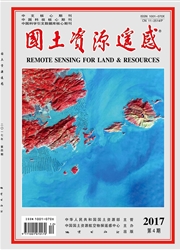

 中文摘要:
中文摘要:
国内生产总值(gross domestic product,GDP)能反映一个国家或地区的经济发展状况,构建高精度的特困区GDP空间数据库对扶贫工作的开展具有重要意义。首先通过建立DMSP/OLS夜间灯光数据与连片特困区GDP的回归模型,实现利用夜间灯光数据估算特困区GDP;然后分别对第一和第二、三产业GDP进行空间化建模:第一产业GDP与土地利用数据相结合建模,第二、三产业GDP与夜间灯光数据相结合建模。研究结果表明,大部分特困区GDP的估算结果较为准确,县级尺度的估算精度达到87.38%;连片特困区多为GDP低密度区,GDP基本处于50万元/km2以下,西北地区甚至出现大片低于5万元/km2。因此,高精度的连片特困区GDP密度分布图能够准确地反映特困区经济分布状况,为扶贫工作的开展提供数据支持。
 英文摘要:
英文摘要:
Gross domestic products( GDP) can represent the economic development conditions of a region,and it is significant for poverty alleviation work to build the GDP spatial databases with high precision. In this paper,a regression model for DMSP / OLS night light data and GDP values in poverty areas was established in groups,and the GDP in continuous poverty areas were retrieved from the night light data. Then the GDP was divided into two parts. One is the GDP of primary industry,and the other is the GDP of second and tertiary industry. Finally,a spatial model for GDP of primary industry was established based on land use data and,in addition,the spatial model for GDP of other two kinds of industries was also built based on night light data. According to the results obtained,the estimation results of GDP are more accurate in most counties; the correlation coefficient between the estimated values and true values is 0. 873 8 at the county level; the continuous poverty areas almost consist of GDP low- density areas; nevertheless,there are a few GDP high- density areas concentrated in towns; the GDP of most continuous poverty areas is less than 500 000 yuan per square kilometer except for the center of town poverty areas,and the GDP is even less than 50 000 yuan per square kilometer in the northwest territories. The economic status can be well reflected by the density distributions map of GDP in poverty areas,which can provide data support for poverty alleviation work.
 同期刊论文项目
同期刊论文项目
 同项目期刊论文
同项目期刊论文
 期刊信息
期刊信息
